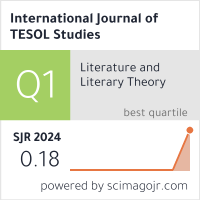2632-6779 (Print)
2633-6898 (Online)


Scopus
Ulrich’s Periodicals Directory (ProQuest)
MLA International Bibliography
MLA Directory of Periodicals
Directory of Open Access Journals (DOAJ)
QOAM (Quality Open Access Market)
British National Bibliography
WAC Clearinghouse Journal Listings
EBSCO Education
ICI Journals Master List
ERIH PLUS
CNKI Scholar
Gale-Cengage
WorldCat
Crossref
Baidu Scholar
British Library
J-Gate
ROAD
BASE
Publons
Google Scholar
Semantic Scholar
ORE Directory
TIRF
China National Center for Philosophy and Social Sciences Documentation
Huameng Yang
Xia Wu
Tsinghua University, China
Abstract
The study explored the relationship between foreign language anxiety, motivation and intercultural communication competence of Chinese university students in top-notch programs. 223 undergraduate students from a leading university in China participated in the study by filling in a battery of questionnaire including the modified versions of Gardner’s Classroom Anxiety Scale and Attitude towards English, Noels et al.’s Language Learning Orientations Scale, Chen and Starosta’s intercultural sensitivity scale, and Portalla and Chen’s intercultural effectiveness scale. 10 of the participants then joined in the follow-up interviews, sharing their personal experience of English learning and intercultural communication. Results indicated that: (1) these students experienced a low-to-medium level of anxiety, and a medium-to-high level of motivation in general, in which intrinsic motivation appeared to be at a higher level than the extrinsic motivation; (2) there was a statistically significant negative correlation between their English use anxiety and English learning motivation; (3) they have experienced a low level of interaction confidence and interaction enjoyment in intercultural communication, and they had also expressed medium to high level in other aspects, for example interactant respect and interaction attentiveness; (4) as for the relationship with intercultural communication competence, the English use anxiety had statistically significant negative correlations with most aspects, while different aspects of English learning motivation had a statistically significant positive correlation with each other. Implications for future research and teaching were also discussed.
Keywords
Anxiety, motivation, intercultural communication competence, top-notch program, EFL